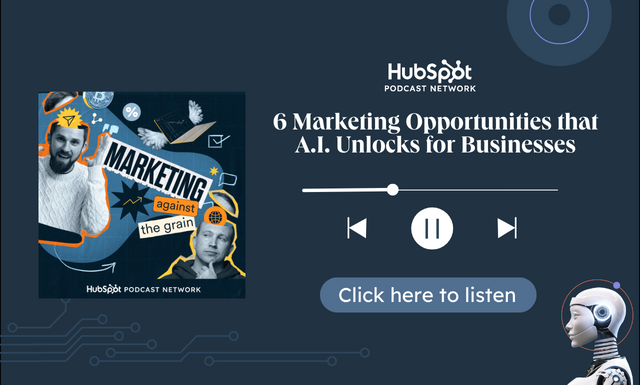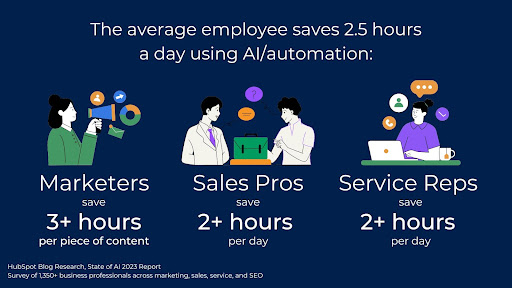“If you’re not using AI, you’re falling behind” is a statement you might have read and heard frequently in the past few months.
It can be a disheartening statement because, as a marketer, you don’t want to be late to the trends, but the amount there is to learn and take in all at once can lead to AI fatigue.
You may feel overwhelmed by the daily AI news cycle — which makes sense. In this post, we’ll discuss six ways to prevent personal AI fatigue.
What is AI fatigue?
AI fatigue can be described as feeling overwhelmed by the current landscape and conversations about AI over the past few months.
The field of artificial intelligence has been around for almost 70 years. We’re currently only using reactive and limited memory AI, and scientists haven’t even begun creating AGI or super AI.
Although not a new concept, AI is currently experiencing what’s been described as a gold rush. And whether you’re looking to leverage AI or launch an AI product, you might not even know where to start.
If that’s you, and you’re feeling a bit of AI fatigue, what can you do about it? Let’s discuss.
Preventing Personal AI Fatigue
1. Understand the basics of AI.
Some AI fatigue might come from not understanding how AI does what it does. Here are some basic definitions of AI and other concepts discussed lately.
Artificial intelligence is computer systems or machines that mimic human capabilities to complete tasks without human input or guidance. AI can interpret and produce speech, solve problems, sort through data, etc. It’s a broad umbrella term.
You might also hear about machine learning, a type of AI where machines analyze large amounts of data points, learn from the data, and develop the ability to make decisions and predictions from that learning. Humans provide the data it learn from, which can be on a specific topic for a single use case or broader applications.
Generative AI is any tool that can answer questions or create images, text, and even video. These tools are powered by machine learning algorithms and use natural language processing (NLP) and natural language generation (NLG) to understand and respond to human input.
With this baseline understanding, processing and engaging with current conversations might be more manageable. If you want more in-depth learning, check out this educational resource for all you need to know about AI.
2. Be selective in what you consume.
There are so many conversations about AI that it might feel like a full-time job to keep up with them. The important thing to note is that not all discussions apply to your specific needs, so you can be selective in what you consume.
The best content to focus on is facts about how AI works, proven results from using AI, and experiences people or other businesses have already had with adopting AI. Everything should be related to your industry because, for example, as a marketer, you’d be better served learning about generative AI writing tools than how healthcare providers use AI to diagnose patients.
Check out this Marketing Against The Grain episode to learn about more marketing opportunities AI unlocks for business.
 Click here to listen to the full episode
Click here to listen to the full episode
3. Learn from others’ experiences with AI.
One of the best things about life is learning from the experiences of others.
If you’re overwhelmed by the possibilities, consider taking a step back to observe. How are similar businesses using AI, reacting to it, or adopting it?
Many businesses are jumping in head first and sharing their results. You can learn from their experience, how it relates to your needs, and how to apply it to your strategy and approach to using AI.
4. Understand its impact on the workforce.
41% of professionals who responded to our State of AI Survey reported they were concerned about AI taking over their jobs in the next few years.
This fear can be a significant factor in AI fatigue, whether it’s left you worried about your employment status or inspired you to start doing everything you can to learn how to use AI in your role.
It’s true that AI will change how we do business, but the general consensus is that AI won’t take our jobs. Instead, it will require some fields and positions to change how jobs are done, which can require people to reskill and learn how to leverage AI in day-to-day processes. Most jobs already expect employees to engage in professional development on the job, so this is nothing new.
Samyutha Reddy, Jasper’s Head of Enterprise Marketing, said that AI will simply focus on elevating marketers – “I think there’s a certain power here that marketers can reclaim, and instead of being the victims in this story of ‘generative AI is coming for marketing,’ I think we can really reposition it as saying, generative AI has landed in the most innovative portion of the enterprise: marketing.”
5. Think about how AI will benefit you, specifically.
Similarly to being selective with what you consume, focus on the benefits AI will bring you, specifically. Focusing on its direct impacts can also build excitement in your research into AI.
For marketers, AI can speed up content creation, help you optimize your email marketing to increase conversion rates and reduce the time it takes to analyze campaign analytics. Generative AI can improve your storytelling and help you with brand marketing initiatives that reach the right audiences.
The most significant impact on your day-to-day is that AI will save you time. The average employee saves almost 2.5 hours a day using AI/automation, and marketers using generative AI save an average of 3+ hours on each piece of content they make.
6. You have the right to take breaks.
Many of the suggestions on this list can help you stay focused, like understanding how AI works and how it applies to you. But, if the noise seems too loud, you can step away and take a break.
The conversations don’t seem to be slowing down, so you can pick back up when you’re ready. As mentioned above, learning from the experiences of others is always a valuable strategy, so you’ll likely have a lot to learn from.
Over to You
Staying on top of business trends is essential, yet AI is a huge field with many applications that aren’t relevant to everyone’s needs. Narrowing in on how it affects you can help control the information overload.
If you’re looking for a low-stakes way to learn more, HubSpot’s State of AI pillar features insights into how marketing professionals currently use AI and topics like AI ethics, types of AI, and even cool jobs that could be created around AI.
![]()

![Free Guide: How to Use AI in Content Marketing [Download Now]](https://i4lead.com/wp-content/uploads/2023/05/3e25e192-30c3-40c1-a7da-a4d054c9e157-6.png)

